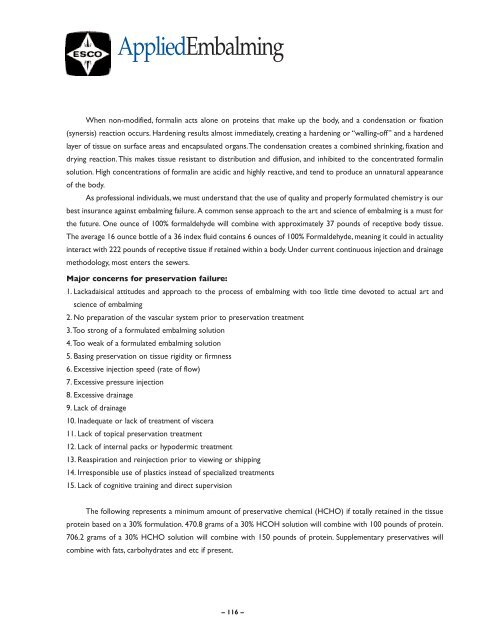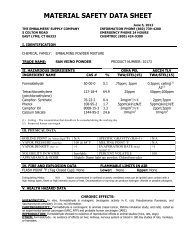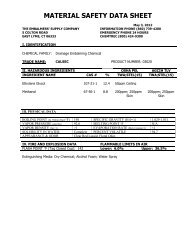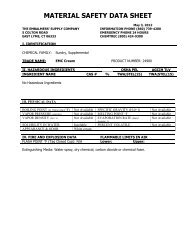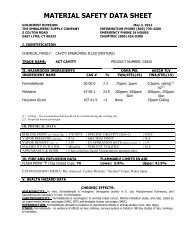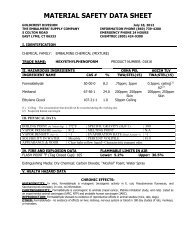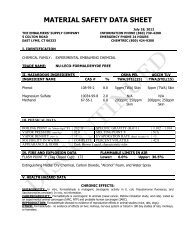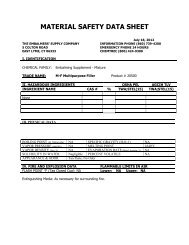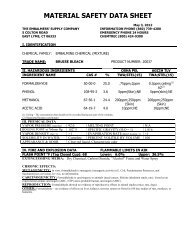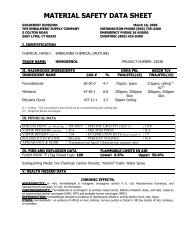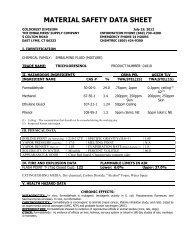Executive Offices - Embalming Supply Company
Executive Offices - Embalming Supply Company
Executive Offices - Embalming Supply Company
Create successful ePaper yourself
Turn your PDF publications into a flip-book with our unique Google optimized e-Paper software.
Applied<strong>Embalming</strong><br />
When non-modified, formalin acts alone on proteins that make up the body, and a condensation or fixation<br />
(synersis) reaction occurs. Hardening results almost immediately, creating a hardening or “walling-off” and a hardened<br />
layer of tissue on surface areas and encapsulated organs. The condensation creates a combined shrinking, fixation and<br />
drying reaction. This makes tissue resistant to distribution and diffusion, and inhibited to the concentrated formalin<br />
solution. High concentrations of formalin are acidic and highly reactive, and tend to produce an unnatural appearance<br />
of the body.<br />
As professional individuals, we must understand that the use of quality and properly formulated chemistry is our<br />
best insurance against embalming failure. A common sense approach to the art and science of embalming is a must for<br />
the future. One ounce of 100% formaldehyde will combine with approximately 37 pounds of receptive body tissue.<br />
The average 16 ounce bottle of a 36 index fluid contains 6 ounces of 100% Formaldehyde, meaning it could in actuality<br />
interact with 222 pounds of receptive tissue if retained within a body. Under current continuous injection and drainage<br />
methodology, most enters the sewers.<br />
major concerns for preservation failure:<br />
1. Lackadaisical attitudes and approach to the process of embalming with too little time devoted to actual art and<br />
science of embalming<br />
2. No preparation of the vascular system prior to preservation treatment<br />
3. Too strong of a formulated embalming solution<br />
4. Too weak of a formulated embalming solution<br />
5. Basing preservation on tissue rigidity or firmness<br />
6. Excessive injection speed (rate of flow)<br />
7. Excessive pressure injection<br />
8. Excessive drainage<br />
9. Lack of drainage<br />
10. Inadequate or lack of treatment of viscera<br />
11. Lack of topical preservation treatment<br />
12. Lack of internal packs or hypodermic treatment<br />
13. Reaspiration and reinjection prior to viewing or shipping<br />
14. Irresponsible use of plastics instead of specialized treatments<br />
15. Lack of cognitive training and direct supervision<br />
The following represents a minimum amount of preservative chemical (HCHO) if totally retained in the tissue<br />
protein based on a 30% formulation. 470.8 grams of a 30% HCOH solution will combine with 100 pounds of protein.<br />
706.2 grams of a 30% HCHO solution will combine with 150 pounds of protein. Supplementary preservatives will<br />
combine with fats, carbohydrates and etc if present.<br />
– 116 –


